 |
 |
 |
 |
 |
 |
| |
 |
|
 |
 |
 |
  |
  |
 |
 |
 |
 |
| 2016 PRITZKER ARCHITECTURE PRIZE | ALEJANDRO ARAVENA
|
|
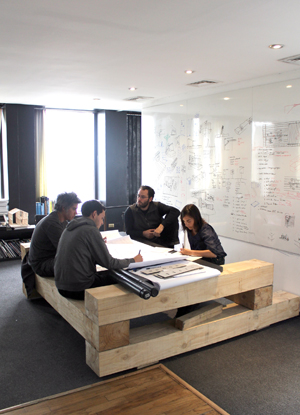 He practices architecture as an artful endeavor in private commissions and in designs for the public realm and epitomizes the revival of a more socially engaged architect. He practices architecture as an artful endeavor in private commissions and in designs for the public realm and epitomizes the revival of a more socially engaged architect.
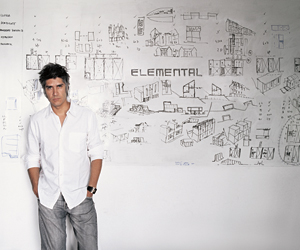 Chicago, IL (January 13, 2016) — Alejandro Aravena of Chile has been selected as the 2016 Pritzker Architecture Prize Laureate, Tom Pritzker announced today Mr. Pritzker is Chairman and President of The Hyatt Foundation, which sponsors the prize. The formal award ceremony for what has come to be known internationally as architecture’s highest honor will be at United Nations Headquarters in New York on April 4, 2016. Chicago, IL (January 13, 2016) — Alejandro Aravena of Chile has been selected as the 2016 Pritzker Architecture Prize Laureate, Tom Pritzker announced today Mr. Pritzker is Chairman and President of The Hyatt Foundation, which sponsors the prize. The formal award ceremony for what has come to be known internationally as architecture’s highest honor will be at United Nations Headquarters in New York on April 4, 2016.
The 48-year-old Aravena is an architect based in Santiago, Chile He becomes the 41st laureate of the Pritzker Prize, the rst Pritzker Laureate from Chile, and the fourth from Latin America, after Luis Barragán (1980), Oscar Niemeyer (1988), and Paulo Mendes da Rocha (2006).
Mr. Pritzker said, “The jury has selected an architect who deepens our understanding of what is truly great design. Alejandro Aravena has pioneered a collaborative practice that produces powerful works of architecture and also addresses key challenges of the 21st century. His built work gives economic opportunity to the less privileged, mitigates the effects of natural disasters, reduces energy consumption, and provides welcoming public space. Innovative and inspiring, he shows how architecture at its best can improve people’s lives.”
Aravena has completed remarkable buildings at the esteemed Universidad Católica de Chile in Santiago, including the UC Innovation Center – Anacleto Angelini (2014), the Siamese Towers (2005), Medical School (2004), School of Architecture (2004), and the Mathematics School (1999). These energy-efficient buildings respond to the local climate with innovative, efficient facades and floor plans and offer the users natural light and convivial meeting places. Currently under construction in Shanghai, China, is an office building for healthcare company Novartis, with of ce spaces designed to accommodate different modes of work — individual, collective, formal and informal In the United States, Aravena has built St. Edward’s University Dorms (2008) in Austin, Texas.
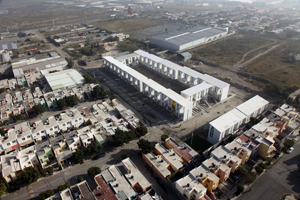 Since 2001, Aravena has been executive director of the Santiago-based ELEMENTAL, a “Do Tank”, as opposed to a think tank, whose partners are Gonzalo Arteaga, Juan Cerda, Victor Oddó, and Diego Torres. ELEMENTAL focuses on projects of public interest and social impact, including housing, public space, infrastructure, and transportation. ELEMENTAL has designed more than 2,500 units of low-cost social housing. A hallmark of the firm is a participatory design process in which the architects work closely with the public and end users. ELEMENTAL is also known for designing social housing that they call “half of a good house”, in which the design leaves space for the residents to complete their houses themselves and thus raise themselves up to a middle-class standard of living. This innovative approach, called “incremental housing”, allows for social housing to be built on more expensive land closer to economic opportunity and gives residents a sense of accomplishment and personal investment Since 2001, Aravena has been executive director of the Santiago-based ELEMENTAL, a “Do Tank”, as opposed to a think tank, whose partners are Gonzalo Arteaga, Juan Cerda, Victor Oddó, and Diego Torres. ELEMENTAL focuses on projects of public interest and social impact, including housing, public space, infrastructure, and transportation. ELEMENTAL has designed more than 2,500 units of low-cost social housing. A hallmark of the firm is a participatory design process in which the architects work closely with the public and end users. ELEMENTAL is also known for designing social housing that they call “half of a good house”, in which the design leaves space for the residents to complete their houses themselves and thus raise themselves up to a middle-class standard of living. This innovative approach, called “incremental housing”, allows for social housing to be built on more expensive land closer to economic opportunity and gives residents a sense of accomplishment and personal investment
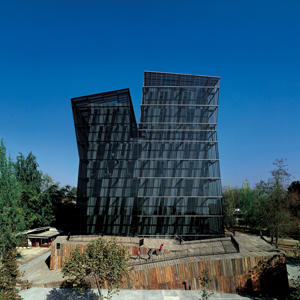 In response to being named the 2016 Laureate of the Pritzker Architecture Prize, Mr. Aravena emailed: “Looking backwards, we feel deeply thankful. No achievement is individual Architecture is a collective discipline. So we think, with gratitude, of all the people who contributed to give form to a huge diversity of forces at play. Looking into the future we anticipate Freedom! The prestige, the reach, the gravitas of the prize is such that we hope to use its momentum to explore new territories, face new challenges, and walk into new elds of action. After such a peak, the path is unwritten. So our plan is not to have a plan, face the uncertain, be open to the unexpected. Finally, looking at the present, we are just overwhelmed, ecstatic, happy It's time to celebrate and share our joy with as many people as possible”. In response to being named the 2016 Laureate of the Pritzker Architecture Prize, Mr. Aravena emailed: “Looking backwards, we feel deeply thankful. No achievement is individual Architecture is a collective discipline. So we think, with gratitude, of all the people who contributed to give form to a huge diversity of forces at play. Looking into the future we anticipate Freedom! The prestige, the reach, the gravitas of the prize is such that we hope to use its momentum to explore new territories, face new challenges, and walk into new elds of action. After such a peak, the path is unwritten. So our plan is not to have a plan, face the uncertain, be open to the unexpected. Finally, looking at the present, we are just overwhelmed, ecstatic, happy It's time to celebrate and share our joy with as many people as possible”.
The 2016 Pritzker Architecture Prize Jury Citation states in part, “Alejandro Aravena has delivered works of architectural excellence in the fields of private, public and educational commissions both in his home country and abroad... He has undertaken projects of different scales from single-family houses to large institutional buildings... He understands materials and construction, but also the importance of poetry and the power of architecture to communicate on many levels”.
Aravena and ELEMENTAL have designed the Metropolitan Promenade (1997 - ongoing) and Bicentennial Children’s Park (2012), both in Santiago. After the 2010 earthquake and tsunami that hit Chile, ELEMENTAL was called to work on the reconstruction of the city of Constitución; their work there includes emergency relief work, a master plan, Villa Verde (incremental housing, 2013), and the Constitución Cultural Center (2014). Other works include a Montessori School (2001) in Santiago, Chile; “Chairless” furniture (2010) for Vitra in Weil am Rhein, Germany; Monterrey Housing (incremental housing, 2010) in Monterrey, Mexico; Las Cruces Pilgrim Lookout Point (2010) in Jalisco, Mexico; Calama PLUS master plan (2012 - ongoing) in Calama, Chile; Writer’s Cabin for the Jan Michalski Foundation (2015) in Montricher, Switzerland; and Ayelén School (2015) in Rancagua, Chile.
Alejandro Aravena is the Director of the Venice Architecture Biennale 2016, titled “Reporting from the Front”, set to open in May 2016.
The Chair of the Jury of the Pritzker Architecture Prize, Lord Peter Palumbo, said that, as the jury visited Aravena’s projects, they felt a sense of wonder and revelation; they understood that his is an innovative way of creating great architecture, with the best yet to come. Referencing John Keats’ poem “On First Looking into Chapman’s Homer”, Lord Palumbo said, "Stout Cortez stared at the Pacific with eagle eyes, whilst the Pritzker jury felt like some watcher of the skies when a new planet swims into his ken: And although not silent upon a peak in Darien, they looked at each other with a wild surmise, captivated, stunned, and overwhelmed by the work of Alejandro Aravena and the promise of a golden future”.
2016 Announcement Video from The Pritzker Architecture Prize on Vimeo.
Jury Citation
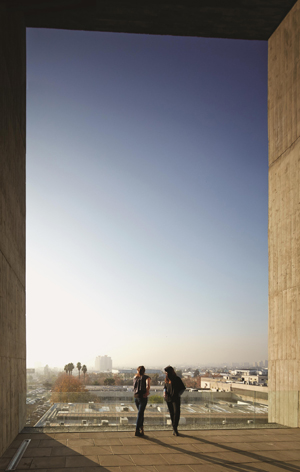 Alejandro Aravena is leading a new generation of architects that has a holistic understanding of the built environment and has clearly demonstrated the ability to connect social responsibility, economic demands, design of human habitat and the city. Few have risen to the demands of practicing architecture as an artful endeavor, as well as meeting today's social and economic challenges. Aravena, from his native Chile, has achieved both, and in doing so has meaningfully expanded the role of the architect. Alejandro Aravena is leading a new generation of architects that has a holistic understanding of the built environment and has clearly demonstrated the ability to connect social responsibility, economic demands, design of human habitat and the city. Few have risen to the demands of practicing architecture as an artful endeavor, as well as meeting today's social and economic challenges. Aravena, from his native Chile, has achieved both, and in doing so has meaningfully expanded the role of the architect.
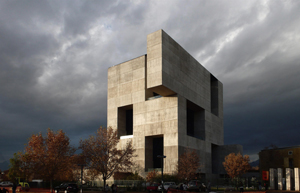 Born in 1967, and practicing since 1994, Aravena has consistently pursued architecture with a clarity of vision and great skill Undertaking several buildings for his alma mater, the Universidad Católica de Chile, including the Mathematics School (1998), Medical School (2001), the renovation of the School of Architecture (2004), Siamese Towers (2005) and more recently the UC Innovation Center – Anacleto Angelini (2014). Each building shows an understanding of how people will use the facility, the thoughtful and appropriate use of materials, and a commitment to creating public spaces to benefit the larger community. In the Angelini Innovation Center, the maturity of this architect is apparent. A powerful structure from a distance, it is remarkably humane and inviting. Through a reversal of convention, the building is an opaque concrete structure on the exterior and has a light lled glass atrium inside. With the mass of the building at the perimeter, the energy consumption is minimal. The interior has many places for spontaneous encounters and transparency that enables viewing activity throughout. Aravena has created a rich environment of lively, interesting and welcoming spaces. Born in 1967, and practicing since 1994, Aravena has consistently pursued architecture with a clarity of vision and great skill Undertaking several buildings for his alma mater, the Universidad Católica de Chile, including the Mathematics School (1998), Medical School (2001), the renovation of the School of Architecture (2004), Siamese Towers (2005) and more recently the UC Innovation Center – Anacleto Angelini (2014). Each building shows an understanding of how people will use the facility, the thoughtful and appropriate use of materials, and a commitment to creating public spaces to benefit the larger community. In the Angelini Innovation Center, the maturity of this architect is apparent. A powerful structure from a distance, it is remarkably humane and inviting. Through a reversal of convention, the building is an opaque concrete structure on the exterior and has a light lled glass atrium inside. With the mass of the building at the perimeter, the energy consumption is minimal. The interior has many places for spontaneous encounters and transparency that enables viewing activity throughout. Aravena has created a rich environment of lively, interesting and welcoming spaces.
Alejandro Aravena has delivered works of architectural excellence in private, public and educational commissions both in his home country and abroad, including the United States — a residence and dining hall at St Edward's University in Austin, Texas — and as far away as Shanghai, China for the pharmaceutical company Novartis. He has undertaken projects of different scales from single-family houses to large institutional buildings. In all his works, he approaches the task with a freshness and ability to start without any predetermined idea or form. He understands materials and construction, but also the importance of poetry and the power of architecture to communicate on many levels.
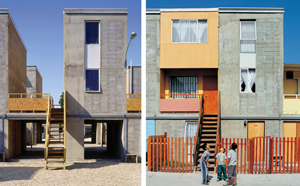 What really sets Aravena apart is his commitment to social housing. Since 2000 and the founding of ELEMENTAL, he and his collaborators have consistently realized works with clear social goals. Calling the company a “Do Tank”, as opposed to a think tank, they have built more than 2,500 units using imaginative, exible and direct architectural solutions for low cost social housing. The ELEMENTAL team participates in every phase of the complex process of providing dwellings for the underserved: engaging with politicians, lawyers, researchers, residents, local authorities, and builders, in order to obtain the best possible results for the benefit of the residents and society. An understanding of the importance of the aspirations of the inhabitants and their active participation and investment in a project, as well as good design, have contributed to the creation of new opportunities for those from underprivileged backgrounds. This inventive approach enlarges the traditional scope of the architect and transforms the professional into a universal gure with the aim of finding a truly collective solution for the built environment. What really sets Aravena apart is his commitment to social housing. Since 2000 and the founding of ELEMENTAL, he and his collaborators have consistently realized works with clear social goals. Calling the company a “Do Tank”, as opposed to a think tank, they have built more than 2,500 units using imaginative, exible and direct architectural solutions for low cost social housing. The ELEMENTAL team participates in every phase of the complex process of providing dwellings for the underserved: engaging with politicians, lawyers, researchers, residents, local authorities, and builders, in order to obtain the best possible results for the benefit of the residents and society. An understanding of the importance of the aspirations of the inhabitants and their active participation and investment in a project, as well as good design, have contributed to the creation of new opportunities for those from underprivileged backgrounds. This inventive approach enlarges the traditional scope of the architect and transforms the professional into a universal gure with the aim of finding a truly collective solution for the built environment.
The younger generation of architects and designers who are looking for opportunities to affect change, can learn from the way Alejandro Aravena takes on multiple roles instead of the singular position of a designer to facilitate a housing project, and by doing so, discovers that such opportunities may be created by architects themselves. Through this approach, he gives the profession of architect a new dimension, which is necessary to respond to present demands and meet future challenges of the field.
Alejandro Aravena epitomizes the revival of a more socially engaged architect, especially in his long-term commitment to tackling the global housing crisis and fighting for a better urban environment for all. He has a deep understanding of both architecture and civil society, as is re ected in his writing, his activism and his designs. The role of the architect is now being challenged to serve greater social and humanitarian needs, and Alejandro Aravena has clearly, generously and fully responded to this challenge. For the inspiration he provides through his example and his contributions to architecture and humanity past and future, Alejandro Aravena is the recipient of the 2016 Pritzker Architecture Prize.
Jury Members
The Lord Palumbo (Chairman)
Architectural patron, Chairman Emeritus of the Trustees, Serpentine Galleries
Former Chairman of the Arts Council of Great Britain
Former Chairman of the Tate Gallery Foundation
London, England
Stephen Breyer
U.S. Supreme Court Justice
Washington, D.C.
Yung Ho Chang
Architect and Educator
Beijing, The People’s Republic of China
Kristin Feireiss
Architecture Curator, Writer, and Editor
Berlin, Germany
Glenn Murcutt
Architect and Pritzker Laureate 2002
Sydney, Australia
Richard Rogers
Architect and Pritzker Laureate 2007
London, England
Benedetta Tagliabue
Architect and Educator
Barcelona, Spain
Ratan N.Tata
Chairman Emeritus of Tata Sons, the holding company of the Tata Group
Mumbai, India
Martha Thorne (Executive Director)
Associate Dean for External Relations IE School of Architecture & Design Madrid, Spain
Biography
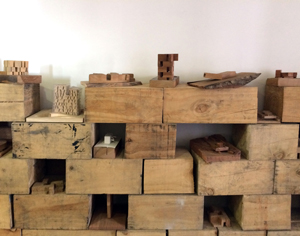 Alejandro Aravena was born on June 22, 1967, in Santiago, Chile. He graduated as an architect from the Universidad Católica de Chile in 1992. In 1994, he established his own practice, Alejandro Aravena Architects. Since 2001 he has been leading ELEMENTAL, a “Do Tank” focusing on projects of public interest and social impact, including housing, public space, infrastructure, and transportation. Alejandro Aravena was born on June 22, 1967, in Santiago, Chile. He graduated as an architect from the Universidad Católica de Chile in 1992. In 1994, he established his own practice, Alejandro Aravena Architects. Since 2001 he has been leading ELEMENTAL, a “Do Tank” focusing on projects of public interest and social impact, including housing, public space, infrastructure, and transportation.
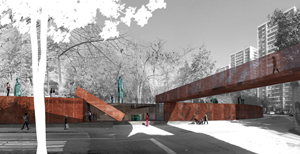 ELEMENTAL has built work in Chile, The United States, Mexico, China and Switzerland. After the 2010 earthquake and tsunami that hit Chile, ELEMENTAL was called to work on the reconstruction of the city of Constitucion, Chile. Aravena's partners in ELEMENTAL are Gonzalo Arteaga, Juan Cerda, Victor Oddó and Diego Torres. ELEMENTAL has built work in Chile, The United States, Mexico, China and Switzerland. After the 2010 earthquake and tsunami that hit Chile, ELEMENTAL was called to work on the reconstruction of the city of Constitucion, Chile. Aravena's partners in ELEMENTAL are Gonzalo Arteaga, Juan Cerda, Victor Oddó and Diego Torres.
Alejandro Aravena is the Director of the Venice Architecture Biennale 2016. He was a speaker at TEDGlobal in Rio de Janeiro, Brazil, in 2014. He was a member of the Pritzker Architecture Prize Jury from 2009 to 2015.
In 2010 he was named International Fellow of the Royal Institute of British Architects and identified as one of the 20 new heroes of the world by Monocle magazine. He is a Board Member of the Cities Program of the London School of Economics since 2011; Regional Advisory Board Member of the David Rockefeller Center for Latin American Studies; Board Member of the Swiss Holcim Foundation since 2013; Foundational Member of the Chilean Public Policies Society; and Leader of the Helsinki Design Lab for SITRA, the Finnish Government Innovation Fund. He was one of the 100 personalities contributing to the Rio +20 Global Summit in 2012.
Aravena was a Professor at the Harvard Graduate School of Design (2000 and 2005); and also taught at Istituto Universitario di Architettura di Venezia (2005), Architectural Association in London (1999), and London School of Economics. He has held the ELEMENTAL Copec Chair at Universidad Católica de Chile since 2006.
Author of Los Hechos de la Arquitectura (Architectural Facts, 1999), El Lugar de la Arquitectura (The Place in/of Architecture, 2002) and Material de Arquitectura (Architecture Matters, 2003). His work has been published in more than 50 countries, Electa published the monograph Alejandro Aravena; progettare e costruire (Milan, 2007) and Toto published Alejandro Aravena; the Forces in Architecture (Tokyo, 2011). Hatje-Cantz published the first monograph dedicated to the social housing projects of ELEMENTAL: Incremental Housing and Participatory Design Manual (Berlin, 2012) launched at the 12th International Architecture Exhibition of la Biennale di Venezia.
Ceremony Venue
Each year the award ceremony is held at a culturally or historically significant venue around the world. The award ceremony for Alejandro Aravena will be held at United Nations Headquarters in New York on April 4, 2016. The location has particular significance as one of its lead designers was 1988 Pritzker Prize Laureate, Oscar Niemeyer. This marks the third time the ceremony will be in New York.
About the Pritzker Architecture Prize
The Pritzker Architecture Prize was founded in 1979 by the late Jay A. Pritzker and his wife, Cindy. Its purpose is to honor annually a living architect whose built work demonstrates a combination of those qualities of talent, vision and excellence, which has produced consistent and significant contributions to humanity and the built environment through the art of architecture. The laureates receive a $100,000 grant and a bronze medallion.
The field of architecture was chosen by the Pritzker family because of their keen interest in building due to their involvement with developing the Hyatt Hotels around the world, and because architecture was a creative endeavor not included in the Nobel Prizes. The procedures were modeled after the Nobels, with the nal selection being made by the international jury with all deliberations and voting in secret. Nominations are continuous from year to year with hundreds of nominees from countries all around the world being considered each year.
History of the Prize
 The Pritzker Architecture Prize was established by The Hyatt Foundation in 1979 to annually honor a living architect whose built work demonstrates a combination of those qualities of talent, vision, and commitment, which has produced consistent and significant contributions to humanity and the built environment through the art of architecture. It has often been described as “architecture’s most prestigious award” or as “the Nobel of architecture.” The Pritzker Architecture Prize was established by The Hyatt Foundation in 1979 to annually honor a living architect whose built work demonstrates a combination of those qualities of talent, vision, and commitment, which has produced consistent and significant contributions to humanity and the built environment through the art of architecture. It has often been described as “architecture’s most prestigious award” or as “the Nobel of architecture.”
The prize takes its name from the Pritzker family, whose international business interests, which include the Hyatt Hotels, are headquartered in Chicago. They have long been known for their support of educational, social welfare, scientific, medical and cultural activities. Jay A. Pritzker, who founded the prize with his wife, Cindy, died on January 23, 1999. His eldest son, Thomas J. Pritzker, has become chairman of The Hyatt Foundation. In 2004, Chicago celebrated the opening of Millennium Park, in which a music pavilion designed by Pritzker Laureate Frank Gehry was dedicated and named for the founder of the prize. It was in the Jay Pritzker Pavilion that the 2005 awarding ceremony took place.
Tom Pritzker explains, “As native Chicagoans, it’s not surprising that we are keenly aware of architecture, living in the birthplace of the skyscraper, a city filled with buildings designed by architectural legends such as Louis Sullivan, Frank Lloyd Wright, Mies van der Rohe, and many others.”
He continues, “In 1967, our company acquired an unfinished building which was to become the Hyatt Regency Atlanta. Its soaring atrium was wildly successful and became the signature piece of our hotels around the world. It was immediately apparent that this design had a pronounced effect on the mood of our guests and attitude of our employees. While the architecture of Chicago made us cognizant of the art of architecture, our work with designing and building hotels made us aware of the impact architecture could have on human behavior.”
And he elaborates further, “So in 1978, when the family was approached with the idea of honoring living architects, we were responsive. Mom and Dad (Cindy and the late Jay A. Pritzker) believed that a meaningful prize would encourage and stimulate not only a greater public awareness of buildings, but also would inspire greater creativity within the architectural profession.” He went on to add that he is extremely proud to carry on that effort on behalf of his family.
Many of the procedures and rewards of the Pritzker Prize are modeled after the Nobel Prize. Laureates of the Pritzker Architecture Prize receive a $100,000 grant, a formal citation certificate, and since 1987, a bronze medal. Prior to that year, a limited edition Henry Moore sculpture was presented to each Laureate.
Nominations are accepted from all nations; from government officials, writers, critics, academicians, fellow architects, architectural societies, or industrialists, virtually anyone who might have an interest in advancing great architecture. The prize is awarded irrespective of nationality, race, creed, gender or ideology.
The nominating procedure is continuous from year to year, closing in November each year. Nominations received after the closing are automatically considered in the following calendar year. The final selection is made by an international jury with all deliberation and voting performed in secret.

Pritzker Prize on AR
Credits
Text and images courtesy of Pritzker Prize/The Hyatt Foundation | ELEMENTAL
Images © ELEMENTAL
Photos by Cristobal Palma, ELEMENTAL, Ramiro Ramirez, Nina Vidic
Drawings by ELEMENTAL, Alejandro Aravena |
|
 |
  |
 |
|
|